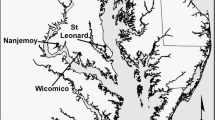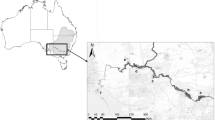Abstract
There has been little research examining the soil seed banks of degraded floodplain wetlands and their contribution to wetland rehabilitation in Australia. Our aim was to assess the establishment of plants from the seed bank that may occur following the delivery of an environmental water allocation to Kanyapella Basin, a 2950 ha wetland located on the floodplain of the Goulburn and Murray Rivers in northern Victoria, Australia. Two hypothetical water regimes were investigated (flooded and dry) in a glasshouse experiment, where plants were left to establish from the seed bank over a period of 124 days. Differences in the establishment of plants from the seed bank indicated that the return of a flooding regime is likely to have a significant effect on the composition of the wetland vegetation. Mapping of the distribution of plant species indicated that propagules were highly dispersed across the wetland for the majority of taxa, in contrast to the localised distribution of many of the plant species represented in the extant vegetation. Inundation favoured the establishment of native wetland and floodplain plants, although many areas of Kanyapella Basin that are currently ‘weed-free’ have the potential to become colonised and potentially dominated by introduced plants if the wetland is not managed appropriately. Overall, results supported the aim of management to reestablish a wetting and drying regime through use of an environmental water allocation. This study presents a significant example of the application of seed bank investigations in wetland ecology and management.
Similar content being viewed by others
References
Abernethy VJ, Willby NJ (1999) Changes along a disturbance gradient in the density and composition of propagule banks in floodplain aquatic habitats. Plant Ecol 140:177–190
Aston HI (1993) New Australian species of Triglochin L. (JUNCAGINACEAE) formerly included in T. procerum R. Br. Muelleria 8:85–97
Aston HI (1995) A review of the tuberous-rooted species of Triglochin L. (JUNCAGINACEAE) in Australia. Muelleria 8:331–364
Britton DL, Brock MA (1994) Seasonal germination from wetland seed banks. Australian J Mar Fresh Res 45:1445–1457
Brock MA, Casanova MT (1997) Plant life at the edge of wetlands: ecological responses to wetting and drying patterns. In: Klomp N, Lunt I (eds) Frontiers in ecology: building the links. Elsevier Science, Oxford, pp 181–194
Brock MA, Theodore K, O’Donnell L (1994) Seed-bank methods for Australian wetlands. Australian J Mar Fresh Res 45:483–493
Brown SC (1998) Remnant seed banks and vegetation as predictors of restored marsh vegetation. Can J Bot 76:620–629
Brown SC, Bedford BL (1997) Restoration of wetland vegetation with transplanted wetland soil: an experimental study. Wetlands 17:424–437
Bunn SE, Arthington AH (2002) Basic principles and ecological consequences of altered flow regimes for aquatic biodiversity. Environ Manage 30:492–507
Casanova MT, Brock MA (1999) Life histories of Charophytes from permanent and temporary wetlands in eastern Australia. Australian J Bot 47:383–397
Casanova MT, Brock MA (2000) How do depth, duration and frequency of inundation influence the establishment of wetland plant communities? Plant Ecol 147:237–250
Clarke KR (1993) Non-parametric multivariate analyses of changes in community structure. Australian J Ecol 18:117–143
Clarke KR, Gorley RN (2000) PRIMER 5 for Windows. PRIMER-E, Plymouth
Clarke KR, Warwick RM (2001) Change in marine communities: an approach to statistical analysis and interpretation. 2nd edn. PRIMER-E, Plymouth
Coops H, van der Velde G (1995) Seed dispersal, germination and seedling growth of six helophyte species in relation to water-level zonation. Fresh Biol 34:13–20
Commonwealth Bureau of Meteorology (2001) Climate records from Echuca aerodrome weather station, Victoria. Commonwealth Bureau of Meteorology, Australia. Source: http://www.bom.gov.au. Accessed September 2001
Cronk JK, Fennessy MS (2001) Wetland plants: biology and ecology. Lewis Publishers, Boca Raton, Fl
Cunningham GM, Mulham WE, Milthorpe PL, Leigh JH (1992) Plants of Western New South Wales, 2nd edn. NSW Soil Conservation Service, NSW Government Printing Office, Sydney
Department of Natural Resources and Environment (2002). Kanyapella Basin 1m Ground DEM and 1 m First DEM LiDAR Geographic Information System Data. Land Information Group, Department of Natural Resources and Environment, Melbourne
Department of Sustainability and Environment (2005). Advisory list of rare or threatened plants in Victoria – 2005. Department of Sustainability and Environment, East Melbourne
Galatowitsch SM, van der Valk AG (1996) The vegetation of restored and natural prairie wetlands. Ecol Appl 6:102–112
Howell J, Benson D (2000) Predicting potential impacts of environmental flows on weedy riparian vegetation of the Hawkesbury-Nepean River, south-eastern Australia. Austral Ecol 25:463–475
Jensen JR, Narumalani S, Weatherbee O (1992) Predictive modelling of cattail and waterlily distribution in a South Carolina reservoir using GIS. Photo Eng Rem Sens 58:1561–1568
Keddy P (2000) Wetland ecology: principles and conservation. Cambridge University Press, Cambridge
Leck MA (1989) Wetland seed banks. In: Leck MA, Parker VT, Simpson RL (eds) Ecology of soil seed banks. Academic Press Inc., San Diego, CA
Leck MA, Brock MA (2000) Ecological and evolutionary trends in wetlands: Evidence from seeds and seed banks in New South Wales, Australia and New Jersey, USA. Plant Species Biol 15:97–112
Legendre P, Legendre L (1998) Numerical ecology (2nd English edn). Elsevier Science, Amsterdam, The Netherlands
Lehmann A, Lachavanne JB (1997) Geographic information systems and remote sensing in aquatic botany. Aqu Bot 58:195–207
Mantel N (1967) The detection of disease clustering and a generalized regression approach. Cancer Res 27:209–220
Mitsch WJ, Gosselink JG (2000) Wetlands. John Wiley and Sons, Inc., New York
Morris K, Bailey PC, Boon PI, Hughes L (2003) Alternative stable states in the aquatic vegetation of shallow urban lakes. II. Catastrophic loss of aquatic plants consequent to nutrient enrichment. Mar Fresh Res 54:201–215
Narumalani S, Jensen JR, Althausen JD, Burkhalter S, Mackey HE Jr (1997) Aquatic macrophyte modeling using GIS and logistic multiple regression. Photo Rem Sens 63:41–49
Nias DJ, Alexander P, Herring M (2003) Watering private property wetlands in the Murray Valley, New South Wales. Ecol Manage Rest 4:5–12
Nicol JM, Ganf GG, Pelton GA (2003) Seed banks of a southern Australian wetland: the influence of water regime on the final floristic composition. Plant Ecol 168:191–205
Poiani KA, Johnson WC (1993) A spatial simulation model of hydrology and vegetation dynamics in semi-permanent prairie wetlands. Ecol Appl 3:279–293
Quinn GP, Keough MJ (2002) Experimental design and data analysis for biologists. Cambridge University Press, Cambridge
Roberts J, Ludwig JA (1991) Riparian vegetation along current-exposure gradients in floodplain wetlands of the River Murray. Australian J Ecol 79:117–127
Roberts J, Marston F (2000) Water regime of wetland and floodplain plants in the Murray-Darling Basin: a source book of ecological knowledge. CSIRO Land and Water, Canberra
Roberts J, Young B, Marston F (2000) Estimating the water requirements of plants of floodplain wetlands: a guide. Occasional Paper 04/00, Land and Water Resources Research and Development Cooperation, Canberra
Robertson HA, James KJ (2002) Determining the water requirements for the rehabilitation of wetland habitat at Kanyapella Basin. Victoria Ecol Manage Rest 3:220–221
Robertson HA, James KJ (2005) Environmental Management Plan for Kanyapella Basin. Prepared for Department of Primary Industries and Department of Sustainability and Environment, Victoria. School of Ecology and Environment Deakin University, Burwood
Robertson HA, McGee TK (2003) Applying local knowledge: the contribution of oral history to wetland rehabilitation at Kanyapella Basin. Australian J Environ Manage 69:275–287
Robertson HA (2006) Environmental water requirements of isolated floodplain wetlands: Kanyapella Basin, Australia. Unpublished PhD Thesis submitted for examination February 2006, Deakin University, Burwood
Romanowski N (1998) Aquatic and wetland plants: a field guide for non-tropical Australia. UNSW Press, Sydney
Ross JH, Walsh NG (eds) (2003) Census of the vascular plants in Victoria. Royal Botanical Gardens, Melbourne
Sainty GR, Jacobs SWL (2003) Waterplants in Australia, 4 edn. Sainty and Associates Pty Ltd, Potts Point, NSW
Schofield N, Burt A, Connell D (2003) Environmental water allocation: principles, practices, policies, progress and prospects. Land and Water Australia, Canberra
Smith SM, McCormick PV, Leeds JA, Garrett PB (2002) Constraints of seed bank species composition and water depth for restoring vegetation in the Florida Everglades. U.S.A. Rest Ecol 10:138–145
van der Valk AG (2000) Vegetation dynamics and models. In: Murkin HR, van der Valk AG, Clark WR (eds) Prairie wetland ecology: the contribution of the Marsh Ecology Research Program. Iowa State University Press, Ames, Iowa, pp 125–161
van der Valk AG, Davis CB (1976) The seed bank of prairie glacial marshes. Can J Bot 54:1832–1838
van der Valk AG, Davis CB (1978) The role of seed banks in the vegetation dynamics of prairie glacial marshes. Ecology 59:322–335
van der Valk AG, Squires L, Welling CH (1994) Assessing the impacts of an increase in water level on wetland vegetation. Ecol Appl 4:525–534
Walsh NG, Entwisle TJ (eds) (1994) Flora of Victoria Volume 2: ferns and allied plants, conifers and monocotyledons. Inkata Press, Melbourne
Walsh NG, Entwisle TJ (eds) (1996) Flora of Victoria Volume 3: dicotyledons - Winteraceae to Myrtaceae. Inkata Press, Melbourne
Walsh NG, Entwisle TJ (eds) (1999) Flora of Victoria Volume 4: dicotyledons – Cornaceae to Asteraceae. Inkata Press, Melbourne
Wilson SD, Moore DRJ, Keddy PA (1993) Relationships of marsh seed banks to vegetation patterns along environmental gradients. Fresh Biol 29:361–370
Williams DC, Lyon JG (1997) Historical aerial photographs and a geographic information system (GIS) to determine effects of long-term water level fluctuations on wetlands along the St. Marys River USA. Aqu Bot 58:363–378
Young WJ (eds) (2001) Rivers as ecological systems: the Murray-Darling Basin. Murray-Darling Basin Commission, Canberra
Acknowledgments
Constructive reviews of earlier drafts of the manuscript were received from Keely Ough, Dr James Fitzsimons and Brooke Turner. Thanks also to Keely Ough for assistance with plant identification and advice on seed bank experiment methodology, Tricia Paradise for help harvesting plants, and Dr Sabine Schreiber for advice on experimental design. Deakin University, Field and Game Australia, Australian Research Council, Goulburn–Murray Water, Parks Victoria, Victorian Department of Sustainability and Environment, Goulburn-Broken Catchment Management Authority and the River Basin Management Society provided financial and/or in-kind support for this project.
Author information
Authors and Affiliations
Corresponding author
Rights and permissions
About this article
Cite this article
Robertson, H.A., James, K.R. Plant Establishment from the Seed Bank of a Degraded Floodplain Wetland: A Comparison of Two Alternative Management Scenarios. Plant Ecol 188, 145–164 (2007). https://doi.org/10.1007/s11258-006-9153-0
Received:
Accepted:
Published:
Issue Date:
DOI: https://doi.org/10.1007/s11258-006-9153-0




